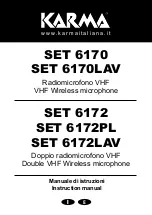
SCHOEPS
GmbH · Spitalstr. 20 · D-76227 Karlsruhe (Durlach) · Tel: +49 721 943 20-0 · Fax: +49 721 943 2050
www.schoeps.de · [email protected]
Start up / Phantom Powering
19
English
for high-frequency loss caused by windscreens
and enhances speech intelligibility.
Pairs of LEDs next to each pushbutton indi-
cate the status of the filters. Green means
“Filter is OFF”, which means constant frequency
response curve. Red means “Warning, filter is
ON”. The settings are retained when the
microphone is switched off.
The LEDs next to each pushbutton let the
operator know the filter settings and whether
the microphone is on, even in the dark.
Start-Up / Phantom Powering
The CMIT 5 U is a condenser microphone. It is
built as a combination of two main compo-
nents: a capsule and a microphone amplifier.
The capsule is the component that converts
sound waves into a varying electrical voltage.
It determines the directionality and, for the most
part, the sound quality of the microphone.
The amplifier of the CMIT 5 U possesses an
electronic circuit needed to polarize (charge)
the capacitive capsule. This hardly influences
the signal, since it only amplifies it, making it
low-impedance so that it can be sent through
a cable. The output is electrically balanced, in
order to eliminate electromagnetic interference
in the cable. This prevents "AC hum“, for
example. Filters cut out high frequencies picked
up by the cable (e.g. from mobile phones).
The microphone amplifier of the CMIT 5 U
has a transformerless, class-AB output stage
without condensers. This is what allows the
low impedance, low distortion and small size.
Start-Up
The CMIT 5 U is an electrically active compo-
nent which requires operating current. This will
most often be supplied by the inputs of a mixer,
preamplifier (such as the SCHOEPS VMS 5U)
or recorder with suitable microphone power-
ing built in.
Like most modern, solid-state professional
microphones, the CCM also uses a standard-
ized powering scheme known as “phantom
powering.” Most recording equipment offers
a 48-Volt supply for such microphones.
Our microphones are developed and tested
with power supplies that conform to the
require ments of this standard. Proper operation
with non-standard power supplies cannot be
guaranteed. Circuit arrangements that deviate
from the standard can cause operational prob-
lems (i.e. distortion or even gaps in the signal),
particularly at high sound pressure levels or in
the presence of strong wind noise. Such prob-
lems may often seem to defy analysis until
their real cause is discovered.
Fig. 1
Input with transformer
(or balanced, ungrounded
transformerless input)
!"#$%&'
("#$%&'
)"*+,
-"*.,
/0123#$34'
5
&12''4
1%67'
#38'2049
:
;
<
;
04#=>
:
;
?+@A"<
;
B
"
+@"C"D"+"CE :
;
B"FG@"H
!
IG
!
/%JK
B"5L"/M
!
N)
!
N)
!
*
Tolerance: ±20%, however, the differ-
ence between the resistors of any one pair
should be less than 0.4% (i.e. 27 Ohms)
XLR-3
Connector
Shield
Microphone
+ Phase
- Phase
Cable
Powering
Input

































